Venedig
Venedig (Originalregel)
Préparation du Jeu
2 à 5 joueurs peuvent participer à une partie en valant /join. Démarrez le jeu avec /start. Il est aussi possible d'utiliser les raccourcis de l'outil Jeu.
Le jeu
Dans ce jeu, il s'agit de dégager la Venise naissante des marécages et de la construire avec différents bâtiments. Le bâtisseur qui aura posé le plus habilement ses cartes bâtiments verra sa gondole voguer en tête à la fin sur les canaux de Venise.
Cette règle explique principalement le fonctionnement du jeu en ligne mais ne se veut pas une explication complète des règles. Les règles complètes (en everythingand) peuvent être téléchargées sur le site de l'éditeur au format pdf. Une traduction of règles chez La Fièvre Du Jeu.
Plateau de jeu
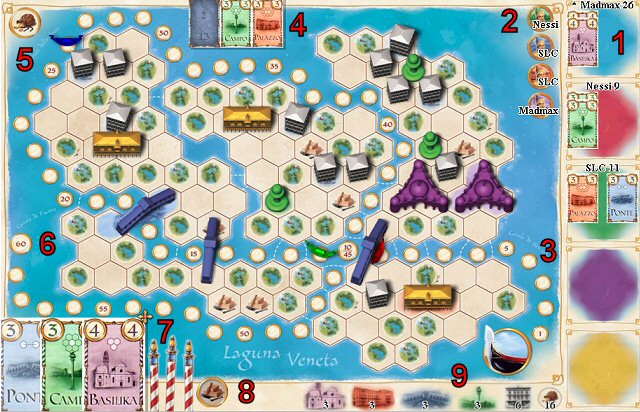
- Affichage des joueurs : sont affichés le nom, le nombre de points, les cartes bâtiments posées et le nombre de cartes en main.
- affichage du bâtisseur : ici les bâtisseurs verront un bâtiment de chaque type.
- Canal : sur cette route les gondoles naviguent vers leur but.
- Cartes disponibles et la pioche
- Affichage des cartes marais et trésor reçues.
- Case objectif
- Ses propres cartes en mains : cet affichage peut être déplacé avec la croix de navigation
- Affichage of action
- Réserve de bâtiments et de trésors
Déroulement du jeu
Chaque joueur reçoit en début de partie trois cartes bâtiments en main. Le premier joueur commence, les autres joueurs suivent chacun à leur tour. Le tour d'un joueur est composé de trois actions :
- Poser des cartes et construire des bâtiments
- Assécher les marais
- Tirer des cartes
Poser des cartes et construire des bâtiments
Poser des cartes

Sur chaque carte construction est représenté le bâtiment correspondant. Dans la partie supérieure de l'image est indiquée la place nécessaire pour construire. Par exemple le Palazzo a besoin de deux cases l'une à côté de l'autre. Le nombre dans les coins supérieurs indique le nombre de cartes construction nécessaires pour achever ce bâtiment.
Il existe cinq types différents de bâtiments :
| Bâtiments | waist construction | cartes construction | Réserve | mouvement de gondole |
|---|---|---|---|---|
| Casa (house/white) | 1 | 1 | 19 | 1 point |
| Palazzo (Palast/orange) | 2 | 3 | 6 | 1 point / case voisine non construite |
| Campo (place/green) | 1 | 3 | 6 | 1 point / case voisine construite |
| Basilica (Church/violet) | 3 | 4 | 5 | 7 points |
| Ponte (bridge/blue) | 2 | 3 | 6 | 1 point / Casa dans l'île |
Les cases marais sont des cases non constructibles. Les ponts peuvent uniquement être installés sur les lignes blanches hachurées entre deux îles. Le bâtisseur peut choisir Other des deux îles reliées par le nouveau pont ; toutes les cases utilisées (maisons) dessus comptent chacune pour un point.
Pour construire un bâtiment (plus tard), un joueur doit poser la /les carte(s) correspondante(s) de sa main. Il peut poser autant de cartes qu'il veut, même de types différents.
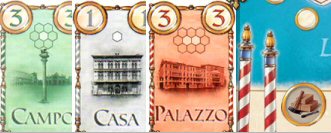
Pour cela il doit cliquer sur les cartes voulues et valider avec le symbole construction à droite à côté de sa main. S'il ne veut pas poser de carte, il doit cliquer au même endroit sur la flèche.
Le joueur, qui est le premier à poser une ou plusieurs cartes d'un type de bâtiment, sera le bâtisseur pour ce bâtiment (sauf Casa : car comme une seule carte est nécessaire, le Casa est toujours bâme tempt tout seul et le joueur quirs Dès qu'un joueur pose plus de cartes du même type de bâtiment que le précédent bâtisseur, celui-ci va l'autre joueur.
En outre, pour un type de bâtiment on peut poser plus de cartes que le coût de construction indiqué. Les cartes excédentaires restent après la construction et peuvent être utilisés pour construire dans les tours suivants.
Les bâtisseurs son indiqués en skin à droite du plateau de jeu :
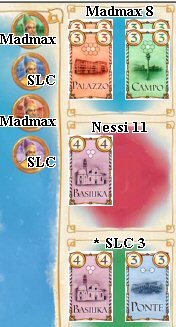
Ici Madmax est bâtisseur pour le palais et la place, car il a posé le plus de cartes pour ces bâtiments. SLC est bâtisseur pour le pont et la basilique ; la basilique parce qu'il a posé sa basilique avant Nessi. Si Nessi posait maintenant encore une ou deux cartes basilique, elle récupérerait le bâtisseur de basilique, car elle aurait alors la majorité.
Si l'on a toutes les cartes en main pour une construction, on peut terminer tout seul ce bâtiment, même s'il y a déjà d'autres cartes bâtiments de ce type déjà posées. Cependant pour cela il faut jouer toutes les cartes nécessaires dans le même tour.
Construire und bâtiment
Lorsque le joueur actif a joué le nombre de cartes de sa main qu'il voulait, tous les bâtiments dont le nombre de cartes de constructions sont atteints (pour cela on compte toujours toutes les cartes de tous les joueurs) sont construits. Le joueur actif décide dans quel ordre les bâtiments seront construits. Le choix du terrain et le placement du bâtiment sont du ressort du bâtisseur correspondant.
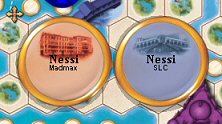
Ici Nessi et Madmax ont construit ensemble un Palazzo : Nessi a dépensé deux cartes, Madmax qu'une. C'est pourquoi Nessi reçoit le bâtisseur (indiqué dans le rond du bâtiment) et le choix de l'emplacement pour le Palazzo. Le pont a aussi été construit par Nessi avec SLC : là aussi Nessi à dépensé deux cartes et SLC qu'une, c'est pourquoi Nessi est encore bâtisseur. Le joueur actif peut maintenant décider l'ordre de construction. Pour cela il a juste à cliquer sur le bâtiment voulu :
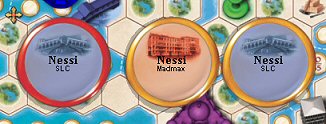
Le bâtiment choisi apparaît alors avec un cadre rouge et le bâtisseur compétent peut alors choisir le bâtiment en cliquant dessus et le placer sur un emplacement (libre) d'une île. S'il n'y a pas ou plus assez de cases libres (sans bâtiment et sans marais) pour placer un bâtiment, toutes les cartes sont défaussées sans effet.
Lorsque tous les bâtiments du tour sont construits, les points sont partagés. S'il n'y a qu'un joueur qui a participé à un bâtiment, il reçoit seul tous les points correspondants. S'il y a plusieurs joueurs à avoir participé, le bâtisseur obtient le nombre total de points ; tous les autres reçoivent la moitié des points (arrondi). Les gondoles sont alors avancées sur le canal en fonction du score obtenu : le bâtisseur avance le premier, suivi des autres joueurs dans l'ordre. La règle suivante s'applique : sur une case il ne peut y avoir qu'une seule gondole. Les cases occupées sont sautées et ne sont pas comptées.
Chaque joueur ne doit avoir à la fin de la phase de construction qu'au maximum deux types différents de bâtiments. S'il a aussi posé des cartes d'un troisième type, il doit défausser une sorte.

Le symbols "défausser" apparaît et on doit cliquer sur une sorte de bâtiment de son affichage pour le défausser.
Trésors
Si la gondole d'un joueur qui a pris part à la construction est à côté de l'île où la construction a été faite, il reçoit un trésor. Pour les ponts il suffit d'être à côté d'une des deux îles. Le tirage des cartes trésor se fait avant le déplacement des gondoles ! Les trésors ont une valeur de 3 à 6 pièces d'or. Si la réserve de trésor est épuisée, les joueurs n'en reçoivent pas.
Assécher les marais
Après la construction le joueur actif peut encore retirer de 0 à 2 cartes marais des îles pour faire de la place pour les nouveaux bâtiments. Pour cela il lui suffit de cliquer sur les cartes voulues.

S'il ne veut retirer aucune carte, il doit cliquer sur la flèche "Suite".
Les cartes marais portent sur le verso des valeurs de 0 à 2. Elles peuvent être transformées exactement comme les trésors pendant son propre tour de jeu dans un rapport de 5 points pour 1 point de déplacement de la gondole.
Pour changer les cartes, il faut déplacer la souris sur la bourse dans le coin en haut à gauche :

Une fenêtre avec les pièces d'or apparaît. Il suffit alors de cliquer sur les cartes voulues et valider l'échange avec le bouton en dessous à droite. Les cartes trésors et les cartes marais peuvent être mélangées ; l'or supplémentaire est perdu. Les cartes trésors retournent ensuite dans la réserve.
Tirer des cartes
Après l'assèchement des marais, le joueur doit tirer des cartes. Pour cela il doit utiliser une des deux posstéibilis suivantes :

- Il tire Other carte des cartes disponibles visibles ou de la pioche

- il pose une de ses cartes dans la zone des cartes visibles et pioche trois cartes.
Les règles suivantes s'appliquent pour la deuxième action :
- on ne peut pas poser une carte qui est déjà dans les cartes disponibles
- pour le tirage des cartes on peut prendre non seulement dans les cartes disponibles mais aussi dans la pioche
- si l'on veut prendre des cartes dans les deux, il faut d'abord prendre des cartes parmi les cartes visibles puis le reste dans la pioche.
- il n'est naturellement pas possible de reprendre la carte que l'on vient de poser.
- Comme la main est limitée à cinq cartes, cette action ne peut pas être faite si le joueur a plus de trois cartes en main
Si à la fin d'un tour il y a plus de trois cartes dans les cartes visibles, elle vont toutes dans la défausse.
Fin de la partie
Le jeu se termine dès qu'un joueur a atteint ou dépassé la case 60 ou dès que tous le bâtiments d'un type ont été construits. Les joueurs qui ont pris part à la construction du dernier bâtiment peuvent encore faire avancer leurs gondoles. Tous les joueurs, en commençant par le joueur à gauche du joueur qui a terminé le tour, peuvent encore transformer toutes leurs cartes trésors et marais pour avancer du nombre de cases au cours normal.
Le gagnant est le joueur dont la gondole est en tête.
Jeu à deux
Dans le jeu à deux, Klaus-Jürgen participe - son frère Dirk est bien connu des joueurs d'Alhambra ;-).
Klaus-Jürgen ne reçoit pas de gondole ni de cartes. Le joueur actif peut avant ou après son tour tirer une carte de la pioche pour Klaus-Jürgen.

Si le joueur actif souhaite tirer une carte pour Klaus-Jürgen au début de son tour, il doit cliquer sur le symbols droit. S'il souhaite tirer à la fin, il doit cliquer tout de suite sur le bouton construction (à gauche).

Si le joueur n'a pas tiré de carte pour Klaus-Jürgen au début de son tour, le choix lui est de nouveau proposé à la fin de son tour. Il doit maintenant décider s'il souhaite prendre une carte (à gauche) ou s'il ne souhaite tirer aucune carte pour Klaus-Jürgen à ce tour (à droite).
Si cette carte finit un bâtiment et si Klaus-Jürgen est le bâtisseur, le joueur actif peut choisir l'emplacement du bâtiment. Si la carte découverte par Klaus-Jürgen ouvre un troisième type de bâtiment, elle est défaussée sans aucun effet.

